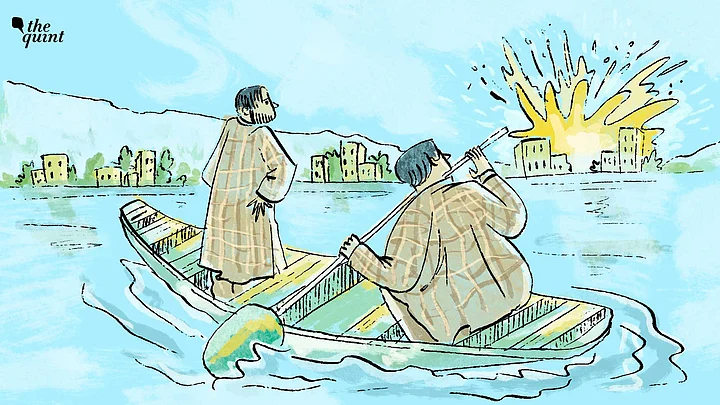The Kashmir Valley was quieter than usual on the morning of 7 May as people huddled worriedly in the front rooms and kitchens of their homes to pore over their phones together, looking at videos and (in some places) discussing the loud noises they heard overhead the night before. Even the din of everyday traffic had ebbed.
As the day wore on, people at large remained glued to their devices, carefully listening to the press conferences being held in New Delhi, and also across the border. The fear of an impending war was palpable, and the noisy ‘war rooms’ of mainstream media only added to the anxiety. Many dealt with it by eagerly seeking out "informed" opinions of locals and experts, even as they scorned the news channels.
In reality, much depends on those screechy channels and the things they broadcast, as the locals knew only too well.
If these channels were able to convince their viewers that “their side” had executed an adequate response against the "other”, the prospect of war might abate. The great danger was that the pressure of public opinion might force escalation—on either side.
In this sense, the subcontinent was (and remains) at a historic crossroads. Statements from both sides suggested that neither India nor Pakistan wanted the situation to escalate into war, and yet, much depends on how public opinion pans out in the coming days.
National Unity over Hypernationalism
Through the detailed press conference, Foreign Secretary Vikram Misri emphasised that India had only hit the training grounds of terrorists as retaliation for the Pahalgam bloodbath, and after reliable intelligence showed that more attacks were being prepared at those centres.
He specifically pointed out that military targets had not been hit, and so there should be no escalation.
Pakistan initially stated that it would respond but, later in the day, Pakistan’s Defence Minister Khawaja Asif said his country was ready to “wrap up” tensions with India if New Delhi de-escalated the situation. For those hoping to avoid the ravages and damage of war, this was indeed a positive development.
Misri’s statement was sober and sensible. Given the regional scenario, in which China has become a major player, the idea that India could take over Pakistan-controlled portions of the erstwhile state of Jammu and Kashmir may be no more than wishful thinking.
On the other hand, a pincer attack by two or more neighbours could present an unprecedentedly tough challenge.
This is a time for Indians to unite to ensure the nation’s security and integrity—leaving aside, for the moment, distress and disappointment over the government’s lapses (as at Pahalgam), diplomatic failures (particularly in the region and with major world powers), and strategic weaknesses (as with armaments aquired over the past decade).
One must appreciate the government for its subtle messaging. It did well to field two women—Colonel Sofiya Qureshi and Wing Commander Vyomika Singh—to present the night’s attacks to the nation at the foreign secretary’s press conference on Wednesday. Together, they presented a picture of national unity and cohesion.
A 78-year-old Kashmiri Pir, SK Abbas, was delighted to see the name of the colonel—Sofiya Qureshi.
"Main gadh-gadh ho gaya. Indian Army ko bahut bahut mubarakbaad," (I was overwhelmed by the gesture. Congratulations to the Indian Army.SK Abbas
Yet, others proudly mentioned that a Kashmiri air force officer, Hilal Ahmad, had been involved in bombing the terrorist training centres.
Some may dismiss it as mere tactical optics but in times of war, optics are important. Battles are fought on the battlefield but the war of perception must be won in the drawing room. It is extremely important at this juncture to not only boost the picture of cohesion the press conference painted but to turn it into reality on the ground across the country. It is the right way to face this challenge, which is, in some ways, unprecedented.
An interesting sidenote to all this, meanwhile, was the apparent shift in Pakistan’s domestic power equations.
The ISI chief Asim Malik was suddenly appointed the country’s National Security Advisor earlier this week. That seemed to somewhat sideline Army chief General Asim Munir, who had hitherto been thought to be the chief power centre in that country—especially since former Prime Minister Imran Khan was jailed, and the subsequent riots were quelled. Munir is said to be close to the US.
One will now see what global forces might lurk behind Malik’s appointment—and how that might influence the course of the events unfolding in the subcontinent.
The Military-Industrial Complex is Watching Too
Despite the performative drum beating on both sides, the fact is that an all-out war would weaken both countries. Conversely, it would be to the advantage of world powers, particularly those who sell weapons. These include China, the US, Israel, France, the UK and Russia.
The UN and several world leaders, including US President Donald Trump, have over the past couple of weeks urged restraint, de-escalation, and dialogue. It is notable that the Western media did not take much notice of the Pahalgam bloodbath, but have played up the rising tensions between the subcontinental rivals.
China has, for its part, made it plain that it would stand solidly behind its “Iron brother” Pakistan if its sovereignty were threatened.
That could make the crucial difference in a war, for Pakistan may not be able to fight a war without Chinese arms, missiles, funding, fuel and other provisions. For now, the Kashmiris who remain in the first line of fire on either side, can only wait and watch their news screens.
(The writer is the author of ‘The Story of Kashmir’ and ‘The Generation of Rage in Kashmir’. He can be reached at @david_devadas. This is an opinion piece and the views expressed above are the author’s own. The Quint neither endorses nor is responsible for the same.)
